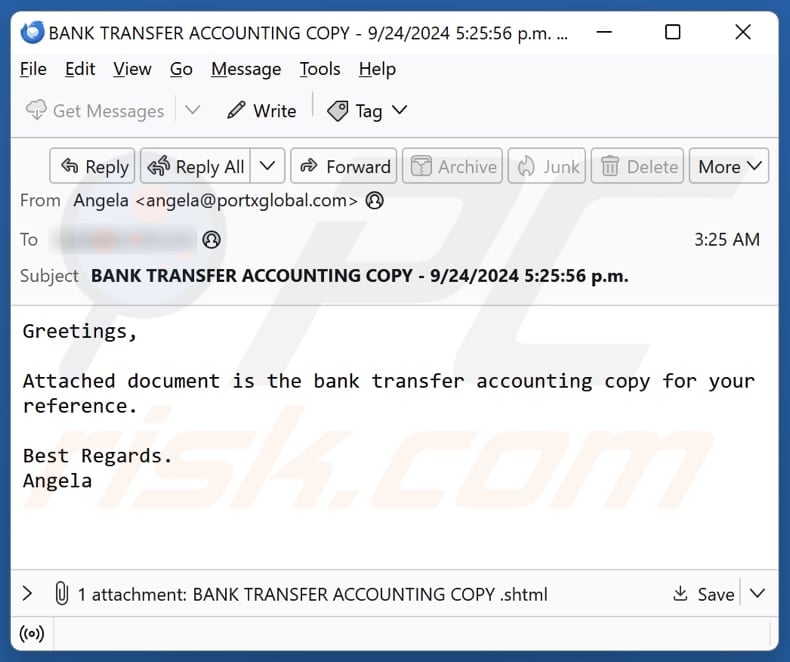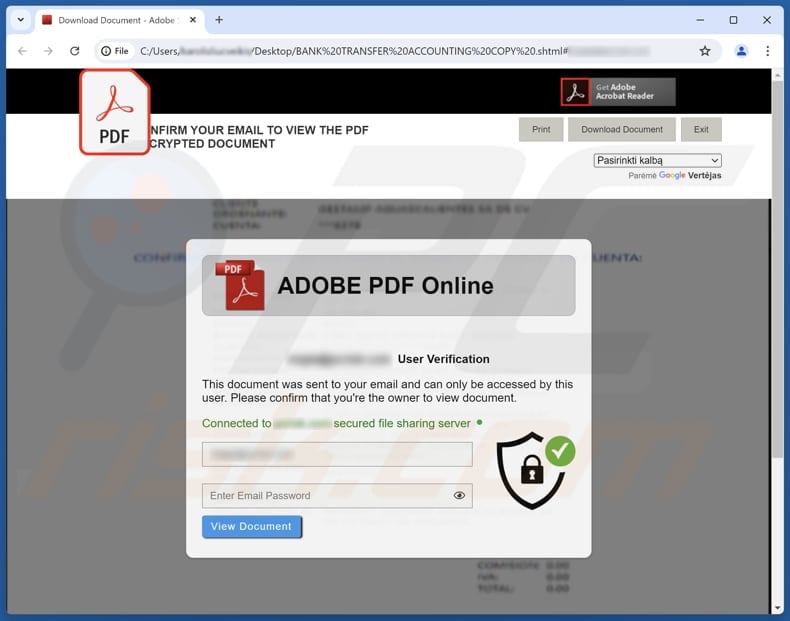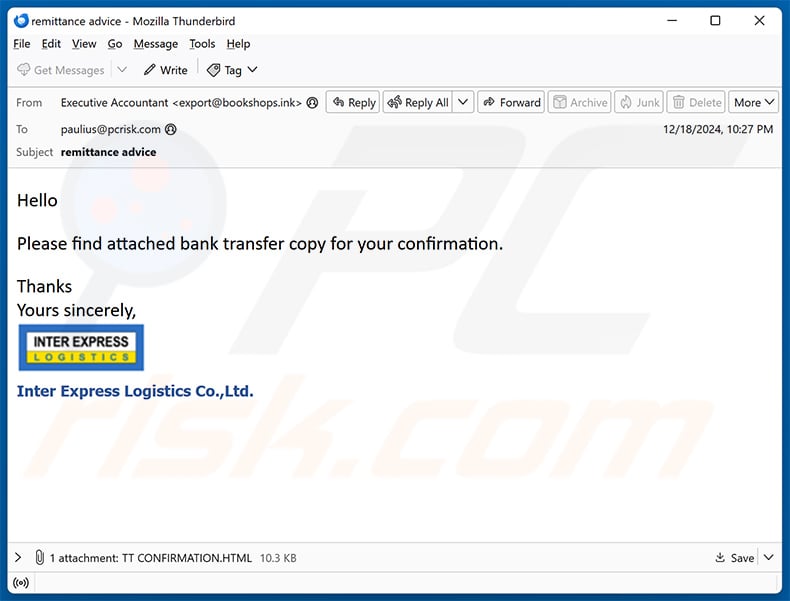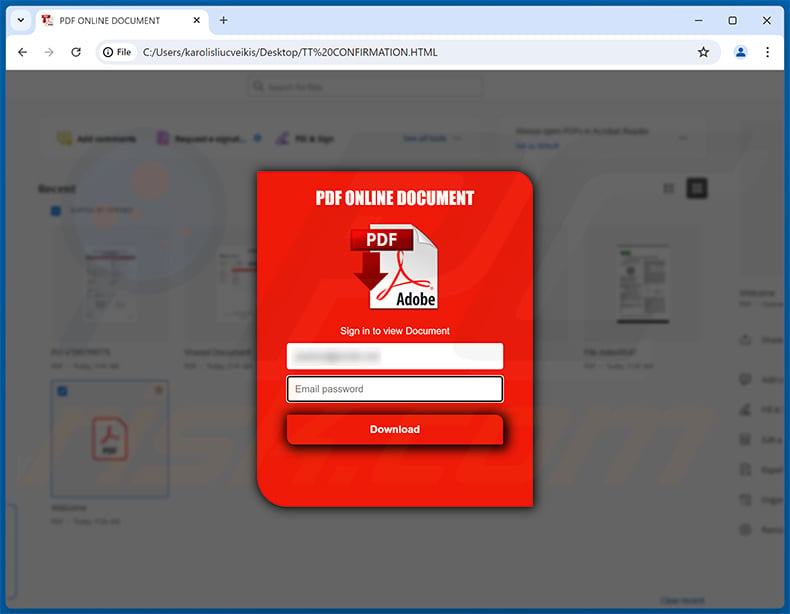How to recognize scams like "Bank Transfer Accounting Copy"
Phishing/ScamAlso Known As: Bank Transfer Accounting Copy phishing email
Get free scan and check if your device is infected.
Remove it nowTo use full-featured product, you have to purchase a license for Combo Cleaner. Seven days free trial available. Combo Cleaner is owned and operated by RCS LT, the parent company of PCRisk.com.
What kind of scam is "Bank Transfer Accounting Copy"?
We have analyzed this email and found that it is a fake notification regarding a bank transfer. The scammers behind this fraudulent email aim to trick recipients into providing personal information. Thus, we classified this letter as a phishing email. Individuals should recognize such emails and ignore them.

More about the "Bank Transfer Accounting Copy" scam email
This fraudulent email states that a bank transfer accounting copy is attached to it. The file attached to it is named "BANK TRANSFER ACCOUNTING COPY .shtml". If opened, it presents a fake Adobe PDF online website instructing the recipient to enter an email account login credentials (an email address and a password) to view the document.
However, the information entered on this form is sent directly to scammers. Cybercriminals can utilize stolen login credentials to access to email accounts and potentially other accounts that share identical or similar login details. Once they have access, they can search for sensitive information, send fake messages to others, or even make unauthorized purchases.
Additionally, scammers can sell stolen login information and other data from hacked accounts on the dark web to other cybercriminals. Victims may have their identities stolen, suffer monetary loss, and encounter other issues. For these reasons, it is important to be careful when receiving suspicious emails and never disclose personal information on shady web pages.
| Name | Bank Transfer Accounting Copy Email Scam |
| Threat Type | Phishing, Scam, Social Engineering, Fraud |
| Fake Claim | The email has a bank transfer accounting copy attached to it |
| Attachment | BANK TRANSFER ACCOUNTING COPY .shtml |
| Detection Names (Attachment) | AliCloud (Trojan:Multi/Nemucod.Gen), Fortinet (JS/Phishing.DOC!tr), Ikarus (Phishing.HTML.Doc), Kaspersky (HEUR:Trojan.Script.Generic), Microsoft (Trojan:Script/Phonzy.B!ml), Full List Of Detections (VirusTotal) |
| Disguise | Letter regarding a bank transfer copy |
| Symptoms | Unauthorized online purchases, changed online account passwords, identity theft, illegal access of the computer. |
| Distribution methods | Deceptive emails, rogue online pop-up ads, search engine poisoning techniques, misspelled domains. |
| Damage | Loss of sensitive private information, monetary loss, identity theft. |
| Malware Removal (Windows) |
To eliminate possible malware infections, scan your computer with legitimate antivirus software. Our security researchers recommend using Combo Cleaner. Download Combo CleanerTo use full-featured product, you have to purchase a license for Combo Cleaner. 7 days free trial available. Combo Cleaner is owned and operated by RCS LT, the parent company of PCRisk.com. |
Similar scam emails in general
Phishing emails often appear as legitimate messages from companies, organizations, or other entities. They instruct recipients to provide personal information directly via email or included files or websites. Once scammers obtain the targeted information, they misuse it for malicious purposes.
Examples of phishing emails are "You Have Crucial Mails Pending", "Internet Corporation For Assigned Names And Numbers (ICANN)", and "Samples Of The Product". It is important to be aware that emails can be used to trick recipients into activating malware on their computers.
How do spam campaigns infect computers?
Threat actors can utilize email to deceive users into infecting their computers by sending malicious files or links. These files can include various formats, such as executables, Microsoft Office documents, ISO files, compressed archives, PDFs, or script files.
Malware can infiltrate systems upon opening these files or after performing certain actions, like enabling macros in Office documents. The links included in these emails can direct users to websites created to deceive them into downloading malware or automatically initiate the download of harmful files or programs.
How to avoid installation of malware?
Carefully review emails before clicking links or opening attachments, particularly if they seem irrelevant, unexpected, or come from unknown senders. Refrain from clicking on ads, buttons, or links on suspicious websites. Always obtain files or software from official websites or reputable app stores.
Additionally, make sure that the operating system and installed programs always have the latest updates, and use a reliable security program to enhance your protection. If you have already opened malicious attachments, we recommend running a scan with Combo Cleaner Antivirus for Windows to automatically eliminate infiltrated malware.
Text presented in the "Bank Transfer Accounting Copy" email letter:
Subject: BANK TRANSFER ACCOUNTING COPY - 9/24/2024 5:25:56 p.m.
Greetings,Attached document is the bank transfer accounting copy for your reference.
Best Regards.
Angela
The phishing form presented in the attached file ("BANK TRANSFER ACCOUNTING COPY .shtml"):

Another example of an email from "Bank Transfer Accounting Copy" spam campaign:

Text presented within:
Subject: remittance advice
Hello
Please find attached bank transfer copy for your confirmation.
Thanks
Yours sincerely,Inter Express Logistics Co.,Ltd.
Screenshot of the attached HTML document designed for phishing purposes:

Instant automatic malware removal:
Manual threat removal might be a lengthy and complicated process that requires advanced IT skills. Combo Cleaner is a professional automatic malware removal tool that is recommended to get rid of malware. Download it by clicking the button below:
DOWNLOAD Combo CleanerBy downloading any software listed on this website you agree to our Privacy Policy and Terms of Use. To use full-featured product, you have to purchase a license for Combo Cleaner. 7 days free trial available. Combo Cleaner is owned and operated by RCS LT, the parent company of PCRisk.com.
Quick menu:
- What is Bank Transfer Accounting Copy phishing email?
- Types of malicious emails.
- How to spot a malicious email?
- What to do if you fell for an email scam?
Types of malicious emails:
![]() Phishing Emails
Phishing Emails
Most commonly, cybercriminals use deceptive emails to trick Internet users into giving away their sensitive private information, for example, login information for various online services, email accounts, or online banking information.
Such attacks are called phishing. In a phishing attack, cybercriminals usually send an email message with some popular service logo (for example, Microsoft, DHL, Amazon, Netflix), create urgency (wrong shipping address, expired password, etc.), and place a link which they hope their potential victims will click on.
After clicking the link presented in such email message, victims are redirected to a fake website that looks identical or extremely similar to the original one. Victims are then asked to enter their password, credit card details, or some other information that gets stolen by cybercriminals.
![]() Emails with Malicious Attachments
Emails with Malicious Attachments
Another popular attack vector is email spam with malicious attachments that infect users' computers with malware. Malicious attachments usually carry trojans that are capable of stealing passwords, banking information, and other sensitive information.
In such attacks, cybercriminals' main goal is to trick their potential victims into opening an infected email attachment. To achieve this goal, email messages usually talk about recently received invoices, faxes, or voice messages.
If a potential victim falls for the lure and opens the attachment, their computers get infected, and cybercriminals can collect a lot of sensitive information.
While it's a more complicated method to steal personal information (spam filters and antivirus programs usually detect such attempts), if successful, cybercriminals can get a much wider array of data and can collect information for a long period of time.
![]() Sextortion Emails
Sextortion Emails
This is a type of phishing. In this case, users receive an email claiming that a cybercriminal could access the webcam of the potential victim and has a video recording of one's masturbation.
To get rid of the video, victims are asked to pay a ransom (usually using Bitcoin or another cryptocurrency). Nevertheless, all of these claims are false - users who receive such emails should ignore and delete them.
How to spot a malicious email?
While cyber criminals try to make their lure emails look trustworthy, here are some things that you should look for when trying to spot a phishing email:
- Check the sender's ("from") email address: Hover your mouse over the "from" address and check if it's legitimate. For example, if you received an email from Microsoft, be sure to check if the email address is @microsoft.com and not something suspicious like @m1crosoft.com, @microsfot.com, @account-security-noreply.com, etc.
- Check for generic greetings: If the greeting in the email is "Dear user", "Dear @youremail.com", "Dear valued customer", this should raise suspiciousness. Most commonly, companies call you by your name. Lack of this information could signal a phishing attempt.
- Check the links in the email: Hover your mouse over the link presented in the email, if the link that appears seems suspicious, don't click it. For example, if you received an email from Microsoft and the link in the email shows that it will go to firebasestorage.googleapis.com/v0... you shouldn't trust it. It's best not to click any links in the emails but to visit the company website that sent you the email in the first place.
- Don't blindly trust email attachments: Most commonly, legitimate companies will ask you to log in to their website and to view any documents there; if you received an email with an attachment, it's a good idea to scan it with an antivirus application. Infected email attachments are a common attack vector used by cybercriminals.
To minimise the risk of opening phishing and malicious emails we recommend using Combo Cleaner Antivirus for Windows.
Example of a spam email:

What to do if you fell for an email scam?
- If you clicked on a link in a phishing email and entered your password - be sure to change your password as soon as possible. Usually, cybercriminals collect stolen credentials and then sell them to other groups that use them for malicious purposes. If you change your password in a timely manner, there's a chance that criminals won't have enough time to do any damage.
- If you entered your credit card information - contact your bank as soon as possible and explain the situation. There's a good chance that you will need to cancel your compromised credit card and get a new one.
- If you see any signs of identity theft - you should immediately contact the Federal Trade Commission. This institution will collect information about your situation and create a personal recovery plan.
- If you opened a malicious attachment - your computer is probably infected, you should scan it with a reputable antivirus application. For this purpose, we recommend using Combo Cleaner Antivirus for Windows.
- Help other Internet users - report phishing emails to Anti-Phishing Working Group, FBI’s Internet Crime Complaint Center, National Fraud Information Center and U.S. Department of Justice.
Frequently Asked Questions (FAQ)
Why did I receive this email?
Scammers often distribute identical generic emails to a large number of recipients, hoping that at least one person will fall for their scheme. If you received such an email, it is purely coincidental and does not indicate any personal targeting.
I have provided my personal information when tricked by this email, what should I do?
If you disclosed your email login credentials to scammers, it is crucial to change your password immediately. Additionally, if you use the same or similar credentials for other accounts, make sure to update those passwords as well to protect them from unauthorized access.
I have downloaded and opened a malicious file attached to this email, is my computer infected?
The file attached to this email is not malicious. However, files sent by cybercriminals can contain malware and infect computers upon opening (or performing additional steps).
I have read the email but did not open the attachment, is my computer infected?
Opening an email itself is safe. However, opening malicious attachments or links contained within fraudulent emails can pose security risks.
Will Combo Cleaner remove malware infections that were present in email attachment?
Combo Cleaner is effective at detecting and removing malware. It can detect almost known malware. However, advanced malware tends to conceal itself deep within the system, so performing a full system scan is necessary to guarantee complete removal.
Share:

Tomas Meskauskas
Expert security researcher, professional malware analyst
I am passionate about computer security and technology. I have an experience of over 10 years working in various companies related to computer technical issue solving and Internet security. I have been working as an author and editor for pcrisk.com since 2010. Follow me on Twitter and LinkedIn to stay informed about the latest online security threats.
PCrisk security portal is brought by a company RCS LT.
Joined forces of security researchers help educate computer users about the latest online security threats. More information about the company RCS LT.
Our malware removal guides are free. However, if you want to support us you can send us a donation.
DonatePCrisk security portal is brought by a company RCS LT.
Joined forces of security researchers help educate computer users about the latest online security threats. More information about the company RCS LT.
Our malware removal guides are free. However, if you want to support us you can send us a donation.
Donate
▼ Show Discussion